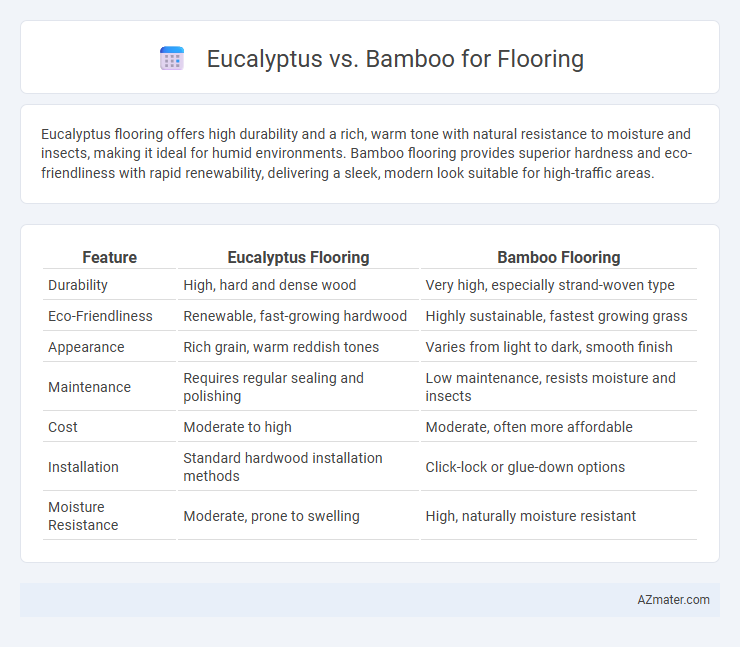Eucalyptus flooring offers high durability and a rich, warm tone with natural resistance to moisture and insects, making it ideal for humid environments. Bamboo flooring provides superior hardness and eco-friendliness with rapid renewability, delivering a sleek, modern look suitable for high-traffic areas.
Table of Comparison
| Feature | Eucalyptus Flooring | Bamboo Flooring |
|---|---|---|
| Durability | High, hard and dense wood | Very high, especially strand-woven type |
| Eco-Friendliness | Renewable, fast-growing hardwood | Highly sustainable, fastest growing grass |
| Appearance | Rich grain, warm reddish tones | Varies from light to dark, smooth finish |
| Maintenance | Requires regular sealing and polishing | Low maintenance, resists moisture and insects |
| Cost | Moderate to high | Moderate, often more affordable |
| Installation | Standard hardwood installation methods | Click-lock or glue-down options |
| Moisture Resistance | Moderate, prone to swelling | High, naturally moisture resistant |
Introduction to Eucalyptus and Bamboo Flooring
Eucalyptus flooring offers exceptional durability and a rich, warm aesthetic derived from its dense hardwood composition, making it a sustainable choice for both residential and commercial spaces. Bamboo flooring, made from rapidly renewable grass, provides superior hardness and moisture resistance, contributing to its popularity in eco-friendly and high-traffic applications. Comparing these materials highlights the distinct benefits in sustainability, hardness ratings, and visual appeal essential for informed Flooring decisions.
Sustainability Comparison: Eucalyptus vs Bamboo
Eucalyptus flooring offers a fast-growing hardwood option with high durability and lower environmental impact due to rapid plantation cycles and carbon sequestration. Bamboo flooring, known for its remarkable renewability, matures within 3-5 years, making it one of the most sustainable flooring materials while providing strength comparable to traditional hardwood. Both eucalyptus and bamboo contribute to reducing deforestation, but bamboo's quicker regrowth and less intensive processing often position it as the more sustainable choice in eco-friendly flooring solutions.
Durability and Hardness Differences
Eucalyptus flooring offers exceptional hardness with a Janka rating of approximately 1,200 to 1,300, making it highly resistant to dents and scratches. Bamboo flooring varies in durability based on type; strand-woven bamboo scores between 1,400 and 1,500 on the Janka scale, exceeding eucalyptus in hardness and durability. The higher density and compressive strength of strand-woven bamboo provide superior longevity and wear resistance compared to the somewhat softer eucalyptus wood.
Aesthetic Appeal and Design Options
Eucalyptus flooring offers a rich, warm tone with a smooth grain that enhances modern and rustic interiors, while bamboo provides a sleek, contemporary look with uniform texture and natural variations that suit minimalist and eco-friendly designs. Both materials are available in various finishes and plank sizes, allowing customization for diverse aesthetic preferences and architectural styles. Eucalyptus's natural color range from golden to reddish hues complements traditional decor, whereas bamboo's light, natural straw shade brightens spaces and pairs well with bold, contrasting elements.
Installation Methods and Ease
Eucalyptus flooring typically employs tongue-and-groove installation, allowing for a secure and stable fit, often requiring professional expertise due to its density and hardness. Bamboo flooring offers versatile installation methods such as click-lock, glue-down, or nail-down, making it suitable for DIY projects and varying subfloor conditions. Both materials demand acclimatization before installation to prevent expansion or contraction, but bamboo's lighter weight generally facilitates easier handling and faster installation times.
Cost Analysis: Eucalyptus vs Bamboo
Eucalyptus flooring typically costs between $3 and $7 per square foot, offering a durable option with moderate pricing, whereas bamboo flooring ranges from $2 to $8 per square foot, providing a budget-friendly to premium spectrum depending on quality and strand-weaving techniques. Installation expenses for both materials are comparable, averaging $3 to $5 per square foot, but eucalyptus may incur higher maintenance costs due to its susceptibility to moisture. Bamboo's rapid growth and renewability contribute to a generally lower environmental impact and potentially lower long-term investment compared to eucalyptus flooring.
Maintenance and Cleaning Requirements
Eucalyptus flooring requires regular sweeping and occasional damp mopping to prevent dirt buildup and maintain its natural luster, while bamboo flooring demands minimal maintenance with just routine dusting and occasional wiping with a damp cloth to avoid water damage. Both materials benefit from using pH-neutral cleaning agents to preserve their finish and prevent discoloration. Eucalyptus is slightly more resilient to scratches and dents, reducing the frequency of repairs compared to bamboo, which is harder but more prone to surface scratches.
Environmental Impact and Certifications
Eucalyptus flooring offers a rapidly renewable resource with a growth cycle of about 10 years, making it an environmentally sustainable choice, especially when sourced from FSC-certified plantations. Bamboo flooring, often certified by the Forest Stewardship Council (FSC) as well, grows even faster--typically 3 to 5 years--and sequesters significant amounts of carbon, contributing to lower overall environmental impact. Both materials provide eco-friendly alternatives to traditional hardwood flooring, with certifications ensuring responsible harvesting and minimal ecological disruption.
Pros and Cons of Eucalyptus Flooring
Eucalyptus flooring offers exceptional durability and resistance to wear, making it suitable for high-traffic areas, while its rich, warm tones provide a natural aesthetic appeal. However, it tends to be harder and less pliable than bamboo, which may lead to increased installation difficulty and potential cracking if not properly acclimated. Eucalyptus also requires regular maintenance to prevent moisture damage and maintain its finish compared to the more water-resistant bamboo.
Pros and Cons of Bamboo Flooring
Bamboo flooring offers exceptional durability and eco-friendliness due to its rapid growth and renewability, making it a popular sustainable choice. Its hardness rivals traditional hardwoods, providing resistance to dents and scratches, but it can be susceptible to moisture damage and humidity-induced warping if not properly sealed. Maintenance is relatively easy with regular cleaning, though bamboo may fade or discolor over time when exposed to direct sunlight.

Infographic: Eucalyptus vs Bamboo for Flooring
 azmater.com
azmater.com